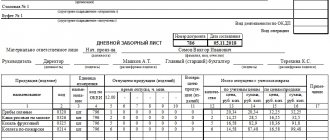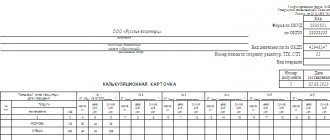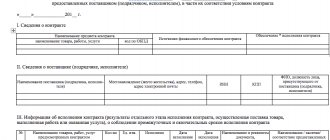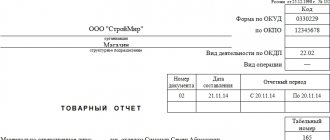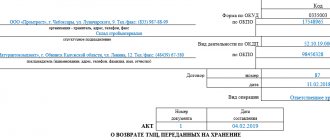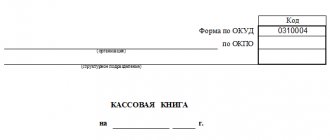An act on the sale and release of kitchen products is drawn up daily on the basis of cash receipts, subscriptions, coupons, invoices and other documents. The corresponding columns of the act show the quantity and cost of dishes for each type of sale. The total amount of dishes sold at actual sales prices is indicated in column 14. Column 16 determines the cost of consumed raw materials at accounting production prices, which is written off from financially responsible persons. This cost is determined by multiplying the book price by the number of dishes sold. Sold and released products are grouped in the act by type of finished product. Portioned dishes with an increased markup are placed in a separate group. The act is an appendix to the record sheet for the movement of products and containers in the kitchen (Form N OP-14).
Today, few people fill out this act manually.
Act on the sale and release of kitchen products op-10
N 132 “On approval of unified forms of primary accounting documentation for recording trade operations.”
To reflect data on the release (sale) of kitchen products, an act on the sale and release of kitchen products (form N OP-10) is used.
Typically, this form is used in restaurants, cafes and other catering organizations, where a form of settlements with consumers is used, which allows obtaining data on the sale of kitchen products by name, quantity and cost.
An act on the sale and release of kitchen products is drawn up daily on the basis of cash receipts, subscriptions, coupons, invoices and other documents.
It must be borne in mind that sold and released kitchen products are grouped in the act by type of finished product.
At the same time, a la carte dishes with an increased markup should be allocated in a separate group.
Unified form of act of write-off of catering products download
Download Unified form of act of write-off of food products
Support of unified printed forms accepted in public catering: OP-1 in the kitchen OP-16 - Statement of accounting for food balances OP-18 - Certificate of transfer of goods INV-3 Acts for destruction, scrap and loss of dishes and utensils (form OP-8). 0504202. Report “Control calculation of product consumption”. All projects. Maintaining a list of interchangeable products and its automatic use when writing off the required set of unified forms: “OP-1” - Calculation card Accounting for the consumption of spices and writing them off at the end of the reporting period. The report corresponds to the unified form “Calculation card”. (document Write-off certificate*). Spices write-off act. 3. Act on the write-off of goods TORG - 16. Act on the removal of remaining products, semi-finished products and finished kitchen products (form OP-15). How to use it to calculate income tax? After all, in public catering, products are written off according to calculations! but in our country, for example, the cross-country ability is low. Act on the write-off of motor vehicles (unified form n OS-4A) act on the write-off of groups of fixed assets (unified form n OS-4B) inventory card for recording a fixed asset object Automation of accounting based on software "1C: Public 8" in SERENA LLC . List of document forms of class 05 OKUD “Unified system of financial, accounting and Act on the write-off of literature excluded from the library. forms specified in the album of unified forms approved by the State Statistics Committee of Russia (Form OP-10 - Act on maintaining several recipes for a dish, writing off spoiled products and dishes, maintaining the Software product "1C: Enterprise 8. Menu-requirement for issuing food products. Printing the required set of standardized forms: “OP-1” - Calculation card sheet, “Torg-13” - Invoice for internal movement, “Torg-16” - Certificate of write-off of goods “1C: Public catering 8” - a software product designed to automate NPF Intech Kazan - O programs 1C-RARUS: CATALOG, REV.5, PROF. Waybill for a non-public bus. Document form. nik_lyk, draw up an act, thank you. Unified form N OP-10. Catering", intended for automation Maximum set of unified forms "OP" They can even order just 1 portion per day. Appendix 1. “INV-19” – Matching sheet, “Torg-13” – Invoice for internal movement, “Torg-16” – Certificate of write-off of goods 0345007.
Sample of filling out an act on the sale and release of kitchen products
Price Issued (time) Returned Product code Unit of measurement code Total issued per day Control number 9.00 12.00 14.00 17.00 19.00 Quantity amount pancakes with meat — — Meat salad — — — — Vinaigrette with herring 100/25 — — — — Total: x
Receipt of the recipient _____________________________________
Receipt of the person who passed it ________________________________________
In total per day thirty-five natural units amounting to twenty-seven thousand six hundred eighty-nine rubles
(in words) (signature)
Released _______________ Accepted _________________
(signature) (signature)
Checked ________________ Checked_________________
(signature) (signature)
No. Date of issue of the fence sheet No. of the fence sheet No. of buffet, tent, kiosk Full name Total¦ 98 ¦ 5 780-00¦ — ¦ — ¦ 5 ¦ 300-00¦ — ¦ — ¦ 103 ¦ 6 080-00¦ X ¦ 2 160-00¦ +———-+———+——— +———-+——-+——-+——-+———+———+———+——-+———+ Total¦ 348 ¦18 361-50¦ — ¦ — ¦ 15 ¦ 764-00¦ 175 ¦9 304-50¦ 538 ¦28 430-00¦ X ¦15 327-50¦ ————+———+———+———-+——-+ ——-+——-+———+———+———+——-+———- ———- Received for preparing dishes from visitors’ products ———- in words —————— ---------- ---------------- rub. ________ kop. Total sold, sold and rendered services for the reporting day Twenty eight thousand four hundred thirty 00 ———————————————— RUB. ——— cop. in words REFERENCE: Spent on preparing dishes 0.27 41 38 spices ——% of turnover in the amount of ——— rub. — cop.
Form OP-5 (filling sample)
So, the procurement act is used to formalize a purchase and sale transaction between an entrepreneur (organization) and an individual seller who is not an entrepreneur. The unified form OP-5 was approved by Decree of the State Statistics Committee of Russia dated December 25, 1998 No. 132. This resolution approved the forms of primary documentation for recording transactions in public catering.
The form is not difficult to fill out, but it can cause difficulties if the entrepreneur has never encountered the preparation of this document. The form (purchase act, form OP-5) is filled out in two copies immediately at the time of purchase of agricultural products. Signed by the person who purchases the products and the seller who sells the products. One copy of the purchase act is given to the seller, the second must remain with the buyer.
In the header of the form, you must fill out the standard details: name of the organization purchasing the products, structural unit, OKPO code, INN, type of activity according to OKDP, type of operation. Next, form OP-5 “Purchasing Act” (we will provide a sample completion at the end of the article) contains the document number, date of completion and information that the act was approved by the manager, indicating the date of approval, signature and transcript of the manager’s signature.
The main part of the document contains the following information:
- Where the goods were purchased (place of purchase of the goods);
- Who purchased the goods (position and full name - last name, first name, patronymic)
- From whom the goods were purchased (last name, first name and patronymic of the individual)
Then the purchase act in form OP-5 contains a table of 7 columns, which contains detailed information about the purchased product:
- Name of the product, characteristics of the agricultural product;
- Agricultural product code;
- The name of the unit of measurement in which this product is measured;
- Unit of measurement code according to OKEI;
- The quantity of goods that was purchased by the buyer;
- The price of the goods indicated in rubles and kopecks;
- The total amount for a given product name;
- At the bottom of the table there is a “Total” line to indicate the total amount that the buyer paid to the seller for the product.
Form OP-5 (you can find it at the end of the article) contains detailed information about the parties to the transaction, which must be filled out in words:
- Transaction amount – the total amount for the product that the buyer pays to the seller;
- Detailed passport data: series, by whom and when issued;
- The home address is indicated on a separate line;
- Data on the certificate of state registration of an entrepreneur carrying out his activities without forming a legal entity: name of the body that issued the certificate, date of issue of the certificate;
- The name in which the certificate was issued, TIN, code of the tax office that assigned the TIN;
- Name of the authority that issued the certificate of the presence of a personal subsidiary plot, date of issue (for residents of the Russian Federation);
- The name in which the certificate was issued;
- The amount of income tax that was withheld;
- The amount of money that the seller received for the goods sold;
- Signature and transcript of the signature of the seller who received the money;
- Buyer's signature confirming receipt of products.
Below you can download the procurement act (form OP-5). The completed procurement act confirms the fact of the transaction, so the necessary information must be filled out correctly and in full. If the seller, an individual, refuses to provide full passport data or sign the document, the act will be considered invalid.
Procurement act, form OP-5 (sample download):
Act on the sale and release of kitchen products (form No. op-10)
Below it, display the total amounts in capital form, and indicate in the certificate the total consumption of spices and salt. The document must be signed by all members of the commission with a clear transcript of their signature and the amount of revenue they verified for the day must also be indicated. You can see an example of filling out an act: example of filling out OP-10.
Important! When selling to small retail outlets, as well as by an employee of the organization, there must be invoices. They should also be attached to this act.
Record sheet for the movement of products and containers in the kitchen (commodity report) (Form N OP-14)
It is used to control the movement and safety of raw materials and finished products in the kitchen, bar, buffet, etc.
Compiled in duplicate daily in value terms by the production manager.
They also write how much salt and spices were used when preparing dishes.
After this, the commission members put their signatures. The amount of revenue received per day must also be indicated. Then the cashier signs, certifying that the amount on the checks and the cost of the products sold match.
At the end, the appendices to the act are listed: invoices, fence sheets, checks.
And the accountant who checked the correctness of all calculations and their compliance with reality signs.
After the accountant checks the act for the correctness of the calculations, he submits it to the manager for approval.
Kitchen product sales report
Reporting on sales of kitchen products
If the dispensing room is separated from production, then the team of dispensing room workers bears financial responsibility for the finished products being distributed. In this case, the transfer of finished products from production to distribution is documented with invoices (for a one-time supply) or daily pick-up sheets (for multiple releases).
When a fence sheet is issued, it is numbered and registered in a special journal. The daily intake sheet is signed by the manager and accountant. When releasing finished products, the production manager fills out a collection sheet in 2 copies as a carbon copy, indicating the release time of each batch of products. Both copies are signed by the production manager and the person who received the finished product. Products not sold during the day are returned to production, which is recorded on the intake sheet.
The manager is obliged to systematically carry out specific checks of the compliance of the actual quantity of kitchen products supplied with the quantity recorded in the intake sheets.
When self-service with advance payment, the buyer receives a receipt for each dish from the cashier and at the end of the shift draws up an act on the sale of finished kitchen products for cash. The total cost of sold dishes must correspond to the revenue as shown in the cash register account.
In last pay self-service, the customer pays the cost of the product to the cashier at the end of the dispensing line, receiving a cash receipt for the total cost. Before issuing a check, the cashier is obliged to “redeem” it (tear it)
In the form of service, when distribution is not separated from production, the volume of products sold is determined by the amount of cash receipts, and the number of dishes is determined on the basis of an audit trail. It is also allowed to draw up an act on the sale of kitchen products for cash in total.
At a POP where waiters serve, the buyer pays the cost of food not to the cash register, but to the waiter, who punches the receipt for each dish on the cash register assigned to him.
When making payments to consumers, it is allowed to use an invoice approved as a strict reporting form without the use of a cash register; in the case of payments for student meals between and the canteen, a subscription book is used. Payment for meals has been made in advance, but the receipt of a cash order or money transferred by payment orders to the bank.
Report on the movement of products and containers in production
In public catering organizations, all financially responsible persons submit reports within the deadlines established by the manager, in agreement with the chief accountant. In addition, these reports are a means of monitoring the movement and safety of inventory items.
In the production of catering organizations, a report is usually compiled on the movement of products and containers in the kitchen.
The financially responsible person draws up a report, usually daily. It contains the indicators “Actual balance of goods”, “Surplus” and “Shortage”, which allows you to directly identify the result of inventory of goods in the report itself, comparing the actual balance with the accounting balance.
Each previous and subsequent report is linked to each other by balances at the end of the day and the beginning of the day, i.e. the balance at the beginning of the day is taken from the previous report in the column “at the end of the day,” etc. for each subsequent report. If the report is prepared the day after the inventory is taken, then the balance at the beginning of the day should be taken from the inventory list.
Each amount of income and expense is confirmed by the relevant documents attached to the report. Receipts are confirmed by invoices from the pantry, expenses - by acts on the sale and release of kitchen products or acts on the sale and release of kitchen products, collection sheets, invoices for the return of products and containers to the pantry, and others.
The report highlights turnover at actual sales prices.
A menu plan and one copy of the menu are attached to the report on the movement of products and containers in the kitchen.
A report on the movement of products and containers in production is drawn up in two copies: the first, with all supporting documents, is submitted to the accounting department, and the second remains with the production manager.
Based on the reports in the accounting department, entries are made in the accounting accounts:
Debit 20 “Main production”
Credit 41 “Goods” subaccount 1 “Goods in warehouses”
— receipt of raw materials from the storeroom to production;
Debit 90 “Sales” subaccount 2 “Cost of sales”
Credit 20 “Main production”
— writing off spent products at discount prices from financially responsible persons;
Debit 41 “Goods” subaccount 2 “Goods in retail trade”
Credit 20 “Main production”
— release of finished products from production to buffets and small retail chains;
Debit 41 “Goods” subaccount 1 “Goods in warehouses”
Credit 20 “Main production”
- returning food from the kitchen to the pantry.
The amount indicated in the column “Turnover at actual sales and selling prices” in the line “Sold for cash” of the report on the flow of products and containers in the kitchen is verified with a similar indicator in the cashier’s cash flow report. And then an entry is made for the specified amount:
Debit 50 "Cash"
Credit 90 “Sales” subaccount 1 “Revenue”
Commodity report (form No. TORG-29), container report (form No. TORG-30) - are used to record commodity documents in trade organizations for the reporting period, which is approved by the head of the organization; drawn up in two copies by the financially responsible person, indicating the number and date of documents for the receipt and disposal of goods and packaging; a commodity report is prepared, as a rule, using the balance method of accounting for goods; signed by the accountant and the financially responsible person; the first copy of the report with the attached documents on the basis of which the report is drawn up is transferred to the accounting department, the second copy remains with the financially responsible person.
Act on the sale and release of kitchen products (form No. OP-10) - used in restaurants, cafes and other public catering organizations, where a form of settlements with consumers is used, which allows you to obtain data on the sale of kitchen products by name, quantity and cost; compiled daily on the basis of cash receipts, subscriptions, coupons, invoices and other documents; the corresponding columns of the act show the quantity and cost of dishes for each type of sale; the total amount of sold dishes at actual sales prices is indicated in column 14; in column 16, the cost of consumed raw materials is determined at accounting production prices, which is written off from financially responsible persons - this cost is determined by multiplying the accounting price by the number of dishes sold; sold and released products are grouped in the act by type of finished product (portioned dishes with an increased markup are allocated in a separate group; it is an appendix to the record sheet for the movement of products and containers in the kitchen (form No. OP-14); signed by members of the commission, including production manager, cashier, stamp maker and is checked by an accountant.The act is an appendix to the accounting sheet for the movement of products and containers in the kitchen.
Record sheet for the movement of products and containers in the kitchen (product report) (form No. OP-14) - used to control the movement and safety of raw materials and finished products in the kitchen, bar, buffet, etc.; compiled in duplicate daily in value terms by the production manager; the first copy with all attached documents is submitted to the accounting department against a signature on the second copy, which remains with the production manager; the movement of products in the statement is reflected at the accounting prices of the kitchen; the movement of spices, salt and containers is recorded in separate columns; the balance at the beginning of the day is transferred from the previous statement or from the inventory list, if the statement is compiled after the inventory; the receipt part of the Statement is filled out according to the receipt documents indicating their numbers; the expense part of the Sheet records the final data of acts of sale (sale) of finished products for cash, as well as data on releases by bank transfer (to buffets, branches, etc.), invoices for the return of products and containers to the pantry; the balance according to accounting data at the end of the day is determined by subtracting the amount “Total in expenses” from the receipt with the balance; in accounting, the Statement and attached documents are carefully checked; the verified Statement serves as a source of information for maintaining synthetic accounting in accounting; the statement is signed by the accountant and the financially responsible person; in case of discrepancies with accounting data, as well as shortages of products and containers, the decision of the manager is recorded in the statement and his signature is affixed.
Bibliography:
- “Accounting in public catering” Kulikova, Peretyatko
- Rasulov N.D. - Accounting in public catering - M.: “Book World”, 2003.
3. Gukkaev V.B. – Accounting in public catering organizations. Accounting and tax aspects. – M.: Gross – Media, 2006. 4. Nikandrova L.K. -Accounting in trade and public catering. – M.:Rior, 2004.
Certificate of sale and release of kitchen products sample filling
Sold and sold at sales prices name code for cash sold to buffets and small retail chains to employees of the organization quantity,
PC.
amount, rub. cop. quantity, pcs. amount, rub. cop. quantity, pcs. amount, rub. cop. quantity,
PC.
amount, rub. cop. QUANTITY
PC.
1 2 3 4 5 6 7 8 9 10 11 12 13 1 Cake “Napoleon” 150-20 10 1502-00 5 751-00 — — — — 15 2 Cake “Fairy Tale” 130-40 15 1956-00 4 521-60 — — — — 19 3 “Honey” cake 140-50 12 1686-00 6 843-00 — — — — 18 4 “Anthill” cake 110-20 14 1542-80 8 881-60 — — — — 22 Total 51 6686 -80 23 2997-20 — — — — 74
Reverse side of form N OP-Yu
Costing card number Finished product Sales price, rub. cop. Sold and sold at sales prices name code for cash sold to buffets and small retail chains to employees of the organization quantity, pcs.
One copy is submitted to the organization’s accounting department, the second remains with the production manager.
Specifications
| Indicators | Portable powder fire extinguisher model | |||
| OP-10 (z) | OP-10 (b) | |||
| TACTICAL, TECHNICAL AND OPERATIONAL CHARACTERISTICS | ||||
| Method for displacing fire extinguishing agent | download | with compressed gas cylinder | ||
| Brand of fire extinguishing agent | PSB-3, PF, Pirant-AN or PHC | P-2AP, PSB-3, PF, Pirant-A | P-2AP, PHC | |
| Weight of fire extinguishing agent charge, kg | 10,0 | 9.5 (PSB-3) 8.0 (Pirant-A) 9.0 (PF) 7.0 (P-2AP) | 6.0 (not less) | |
| Fire extinguishing ability | 4A, 144V | 4A, 144V | 3A, 89B | |
| Working pressure, MPa | 1,6 | 1,0 | 1,0+0,2 | |
| Duration of fire extinguishing agent supply, s | 13 (at least) | 10 (at least) | 14-2 | 20 |
| Fire extinguishing agent jet length, m | 4,5 | 4,5 | 5,0 | 4.5 (not less) |
| Operating temperature range, °C | -40…+50 | -20…+50 | -30…+50 | -50…+50 |
| Total weight, kg | 16,0 | 12-15,5 | 15,5 | 16.8 (no more) |
| Overall dimensions, mm | 350x670 | no data | 200x430x420 | 700x165 |
| Average service life, years | 10 years | |||
Important: The technical characteristics are typical; they may differ for each manufacturer, so it is necessary to compare these parameters before making the final selection and purchase of a fire extinguisher.
Act on the sale and release of kitchen products form op-10 sample filling
Thus, the corresponding columns of the act show the quantity and cost of dishes for each type of sale. The total amount of dishes sold at actual sales prices is indicated in column 14. Column 16 determines the cost of consumed raw materials at accounting production prices, which is written off from financially responsible persons. This cost is determined by multiplying the book price by the number of dishes sold.
The act on the sale and release of kitchen products is signed by members of the commission, including the production manager, cashier, and stamp maker, and is checked by the accountant of the catering enterprise.
Next, we will consider the procedure for filling out the unified form of the act on the sale and release of kitchen products.
Example. Catering enterprise (Sladko LLC) March 23, 2020
Attention
The journal is kept by the person responsible for the safety of tableware and cutlery (deputy director, hall manager, waiter foreman), etc. When automated processing of document data by means of computer technology, it is possible to use the proposed form in the form of a separate statement on paper and computer storage media. Signed by the financially responsible person and employees to whom tableware and cutlery are issued for reporting.
SALES OF PRODUCTS AND GOODS BY PUBLIC CATERING ORGANIZATIONS
Documenting
Products and goods are transferred to the buffet, bar, and other public catering facilities from the pantry using a consignment note; from production (kitchen) - according to the commodity (consignment note) and the fence sheet. The invoice, which is used to transfer products (finished products) from production (kitchen), indicates the accounting price of production (kitchen). If the release of products and goods is carried out according to a pick-up sheet, then two prices may be indicated on it - one for writing off the cost of products (finished products) from the pantry (production), the other for posting them in a buffet, bar, or other public catering facility.
Goods received directly from suppliers are accounted for according to goods and delivery notes issued by the supplier. Calculation of sales prices for received goods is carried out on a separate form (register), which is attached to the invoices.
At the end of the day (shift), the quantity and cost of each item of food supplied is calculated and the total cost of production is determined in two estimates: at actual sales prices and at accounting production prices.
In accordance with the adopted accounting policy of the organization, accounting for the sale of finished products can be carried out in cost or quantitative-cost terms. In the first case, the products released during the working day are indicated in the act of sale and release of kitchen products (Appendix 17 to the Methodological recommendations for documenting and recording commodity transactions in retail trade and public catering, approved by order of the Ministry of Trade of the Republic of Belarus dated 04/09/2007 No. 74 ; hereinafter - Methodological Recommendations No. 74), in the second - in the act on the sale of finished kitchen products for cash (Appendix 18 to Methodological Recommendations No. 74).
The products released during the working day (shift) for each type of dish are entered into the act on the sale of finished kitchen products for cash, which is drawn up in one copy. If products are sold during the day with the same amount of public catering markup, then columns 1-5 are filled in in the said act, and the result of the column “at actual sales prices - amount” will be equal to the cost of raw materials and products spent on the production of dishes at accounting production prices.
If products are sold at different prices during the day (for example, at lunchtime and in the evening), then in columns 4 and 5 the prices and amounts for cash register receipts are entered, and the total amounts of the cost of products sold at lunchtime and in the evening must correspond to the readings of cash counters .
If kitchen products are sold for cashless payment, an act for the supply of food by bank transfer is drawn up (Appendix 19 to Methodological Recommendations No. 74).
The supply of food to the staff of a public catering organization is carried out according to the act for the supply of food to the employees of the organization (Appendix 16 to Methodological Recommendations No. 74), drawn up in the prescribed manner. In order to personalize the employees to whom food was provided, the act (on its reverse side) must indicate a list of such employees and the total cost of food provided to each employee.
The final data of the act on the supply of food to employees of the organization serves as the basis for drawing up an act on the sale and supply of kitchen products.
The financially responsible person (bartender, seller) must draw up a daily commodity report, which indicates the amounts for all receipts and expenditure documents (receipt for the receipt cash order for the delivery of proceeds, invoice for the return of unsold products, act for destruction, scrap, damage to goods and etc.) and displays the balance of goods at the end of the reporting period.
When financially responsible persons work in shifts, values located in a unit of a public catering facility can be transferred from one materially responsible person (team) to another under an act of transfer of goods and containers when changing the materially responsible person (Appendix 26 to Methodological Recommendations No. 74). The said act is drawn up in two copies. One copy is intended for the financially responsible person who transferred the valuables, the other - for the person who accepted them.
The financially responsible person who transferred the goods attaches the act to the goods report. The total value of the transferred valuables must correspond to the preliminary balance of goods (cash and goods) according to his last commodity report. The cost of the valuables transferred under the act is recorded in the expense section of the commodity report. If there is no discrepancy between the accounting and actual availability of valuables from the financially responsible person, there will be no balance of valuables according to the commodity report. The presence of a balance in the goods report indicates a shortage of valuables.
The balance on the product report, recorded in red ink ( using the “red reversal” method
), is the sum of the surplus. The financially responsible person who accepted the goods also attaches the act to the commodity report, recording it in the receipt part of the report.
Accounting in retail and public catering
In accounting, account 41 “Goods” is intended to summarize information on the availability and movement of goods (including during transit), containers, except those used for the implementation of the technological production process (technological containers) and for business needs, in organizations engaged in trading , trade and production activities.
Subaccount 41-1 “Goods in warehouses” takes into account the availability and movement of goods located in warehouses, pantries, vegetable stores, refrigerators, etc.
Subaccount 41-2 “Goods in retail trade” takes into account the availability and movement of goods and glassware in organizations engaged in retail trade.
Acceptance for accounting of goods and containers received by the organization is reflected in the debit of account 41 and the credit of accounts 60 “Settlements with suppliers and contractors”, 42 “Trade margin” (when accounting for goods at retail prices), 71 “Settlements with accountable persons”, 75 “Settlements with founders”, 98 “Deferred income” and other accounts.
The cost of goods sold, when reflecting revenue from their sale in accounting, is reflected in the debit of account 90 “Income and expenses from current activities” and the credit of account 41.
Analytical accounting for account 41 is carried out by item (grades, lots, bales), if necessary - by storage location of goods (clause 32 of the Instructions on the procedure for applying the standard chart of accounts for accounting, approved by Resolution of the Ministry of Finance of the Republic of Belarus dated June 29, 2011 No. 50; hereinafter referred to as Instruction No. 50, Resolution No. 50).
The current standard chart of accounts established by Resolution No. 50 does not provide for subaccounts to account 42. In this regard, it is advisable to use the following subaccounts to reflect discounts, as well as surcharges and VAT included in the price of goods:
• 42-1 “Trade allowance and margin”;
• 42-2 “Supplier discount”;
• 42-3 “VAT on retail prices”.
Let's look at practical situations.
| Situation 1 The bar received goods from the supplier in the amount of 840,000 rubles, incl. VAT at the rate of 20%. Also, goods worth RUB 345,000 were transferred from the warehouse. at discount prices and finished products from the workshop in the amount of RUB 2,720,000. at sales prices. Goods in the warehouse and in the bar are recorded at retail prices. The trade markup is 30%. In accounting, these transactions are reflected as follows. |
| Contents of operation | Debit | Credit | Amount, rub. |
| Goods received from supplier | 41-2 | 700 000 | |
| VAT is reflected on goods received | 60 | 140 000 | |
| The trade markup included in the retail price of goods is reflected (700,000 x 30/100) | 41-2 | 42-1 | 210 000 |
| VAT included in the retail price of goods is reflected (910,000 x 20/100) | 41-2 | 42-3 | 182 000 |
| Goods have arrived from the warehouse | 41-2 | 41-1 | 345 000 |
| Finished products arrived from the workshop | 41-2 | 2 720 000 |
In accounting, account 90 is intended to summarize information about income and expenses related to the current activities of the organization, as well as to determine the financial result for it.
Account 90 reflects revenue from the sale of products, goods, works, services, taxes and fees calculated from the proceeds from the sale of products, goods, works, services, cost of sales of products, goods, works, services, administrative expenses, sales expenses, other income and expenses for current activities (clause 70 of Instruction No. 50).
The amount of the premium for the balance of unsold goods and products in public catering organizations can be determined based on average percentage calculations.
| Situation 2 The balance on subaccount 42-1 at the beginning of the month is 16,354,200 rubles, the credit turnover on subaccount 42-1 for the month is 395,760,400 rubles, the balance of goods and products at sales prices is 40,022,800 rubles, goods and products sold per month at sales prices - 614,835,600 rubles, incl. paid by bank cards - RUB 224,305,200. The estimated VAT rate is 15.720 5%. Goods worth RUB 676,500 were returned to the warehouse. at retail prices. In the warehouse, records are kept at purchase prices. The VAT rate on returned goods is 20%, trade markup is 7%. We will calculate the amounts of trade markups (margins) on the balance of unsold goods and products. |
| Balance on subaccount 42-1 at the beginning of the month | Credit turnover on subaccount 42-1 | Total (column 1 + group 2) | Balance of goods and products at the end of the month | Products and goods sold per month | Total (gr.4 + gr.5) | Average percentage of realized trade markups and margins (group 3 / group 6 x x 100) | The amount of trade markups (margins) attributable to goods and products sold (column 5 x gr.7 / 100) | The amount of trade markups (margins) attributable to the balance of goods and products (column 3 - column 8) |
| 1 | 2 | 3 | 4 | 5 | 6 | 7 | 8 | 9 |
| 16 354 200 | 395 760 400 | 412 114 600 | 40 022 800 | 614 835 600 | 654 858 400 | 62,931 9 | 386 927 725 | 25 186 875 |
In accounting, these transactions are reflected as follows.
| Contents of operation | Debit | Credit | Amount, rub. |
| Products and goods sold for cash | 90-1 | 390 530 400 | |
| Products and goods sold using bank cards | 224 305 200 | ||
| Sold products and goods at sales prices are written off | 90-4 | 41-2, | 614 835 600 |
| The “red reversal” method reflects the amount of VAT included in the price of products and goods sold (614,835,600 x 15,720 5/100) | 90-4 | 42-3 | 96 655 230 |
| The “red reversal” method reflects the amount of trade markups and markups included in the price of sold products and goods (calculation) | 90-4 | 42-1 | 386 927 725 |
| VAT accrued on product sales | 90-2 | 68-2 | 96 655 230 |
| Goods from the cafe were returned to the warehouse | 41-1 | 41-2 | 676 500 |
| The “red reversal” method reflects VAT included in the retail price of goods returned to the warehouse (676,500 x 20/120) | 41-1 | 42-3 | 112 750 |
| The “red reversal” method reflects the trade markup included in the retail price of goods returned to the warehouse ((676,500 - 112,750) x 7 / 107) | 41-1 | 42-1 | 36 881 |
Taxation of organizations engaged in retail trade and provision of public catering services
| From the editors of "Business-Info" The material refers to the Tax Code of the Republic of Belarus as amended before January 1, 2020. From January 1, 2020, the above-mentioned Code is set out in a new edition by the Law of the Republic of Belarus dated December 30, 2018 No. 159-Z. Regarding taxation, the material is relevant as of the date of its writing. Since February 16, 2020, Resolution of the Ministry of Taxes and Duties of the Republic of Belarus dated January 3, 2019 No. 2 “On the calculation and payment of taxes, fees (duties), and other payments” has been in effect. |
The objects of VAT taxation are the turnover of sales of goods (work, services), property rights on the territory of the Republic of Belarus (subclause 1.1, clause 1, article 93 of the Tax Code of the Republic of Belarus; hereinafter referred to as the Tax Code).
Payers engaged in retail trade and activities providing public catering services can calculate VAT on goods based on the tax base and the share of the VAT amount on goods available in the reporting period in the cost of these goods (including all taxes, fees (duties) and other mandatory payments to the budget or state extra-budgetary funds levied upon the sale of goods), including goods exempt from VAT.
For goods, including imported ones, sold at free and regulated retail prices by payers engaged in retail trade and provision of public catering services, receiving income in the form of differences in prices, markups, surcharges and calculating VAT in accordance with part one of clause 9 of Art. 103 of the Tax Code, the tax base is the cost of goods sold (including all taxes, fees (duties) and other obligatory payments to the budget or state extra-budgetary funds levied upon the sale of goods).
In the absence of separate accounting of VAT amounts included in the price of goods, as well as separate accounting of turnover on the sale of goods taxed at different tax rates, VAT on the sale of goods at retail prices is calculated at the rate specified in subclause 1.3 of clause 1 of Article 102 NK, i.e. at a rate of 20% (part one of Article 103 of the Tax Code).
Payers who apply the calculated rate include turnover from the sale of goods, which is exempt from VAT, in the total amount of retail turnover. In this case, there is no reason to fill out the corresponding line of the tax return (calculation) for value added tax, which reflects transactions exempt from VAT (page 8 of the tax return (calculation) for value added tax, established by a resolution of the Ministry of Taxes and Duties of the Republic Belarus dated November 15, 2010 No. 82; hereinafter referred to as Resolution No. 82).
To apply the estimated VAT rate, the following conditions must be met:
1) the estimated VAT rate applies only to goods sold at retail prices - free and regulated (fixed). Moreover, goods can be sold to both individuals and legal entities;
2) the estimated VAT rate does not apply to turnover from the sale of fixed assets, intangible and other assets, as well as to turnover from the sale of work (services);
3) when determining the estimated VAT rate, the amount of tax included in the price of goods is divided by the total cost of goods, including goods exempt from VAT, which leads to a reduction in the amount of the estimated rate;
4) to apply the calculated rate, the payer is obliged to provide:
— accounting of goods at sales prices (at sales prices). In this case, the selling price includes all taxes, fees and deductions levied upon the sale of goods;
— separate accounting of VAT amounts included in the price of goods, as well as the availability of separate accounting of turnover for the sale of goods taxed at different rates.
The form for calculating value added tax based on the tax base and the share of the amount of value added tax when selling goods at retail prices and the procedure for filling it out are established by Resolution No. 82 (subclause 11.2, clause 11, Appendix 226 to Resolution No. 82).
In 2014, this form is not an attachment to the tax return (calculation) for value added tax, and therefore is not submitted to the tax authority.
However, the form for calculating the estimated rate is required to be filled out, since based on the specified calculation, the payer fills out page 10 of the tax return (calculation) for value added tax. This calculation must be kept by the payer and presented to the tax authority upon his request either during a desk audit or during an on-site audit.
| Situation 3 A catering organization (cafe) purchases and sells products and goods that are taxed at rates of 20 and 10%. There is no work in progress. The balance on the credit of account 42 (VAT) at the beginning of the month is 12,620,900 rubles; balance on the debit of account 41 at the beginning of the month - 71,058,500 rubles; products and goods sold for the month - 361,422,400 rubles; turnover on credit account 42 (VAT) for the month - 43,810,500 rubles; turnover on the debit of account 41 (receipt of products and goods) for the month - 369,386,700 rubles; balance on the debit of account 41 at the end of the month - 79,022,800 rubles. (71,058,500 + 369,386,700 – 361,422,400). |
| CALCULATION of value added tax based on the tax base and the share of the amount of value added tax when selling goods at retail prices | |||||||||
| (thousand roubles.) | |||||||||
| Name of the store or public catering establishment | Account balance 42 (VAT) | Value added tax on goods received (turnover on the credit of account 42 (VAT)) | Preliminary balance for VAT at the end of the month (column 2 + column 3) | Cost of goods (products) | Estimated VAT rate ((gr.4 / / gr.7) x x 100) | Value added tax on the balance of goods ((gr.6 x gr.8) / / 100) | Value added tax calculated on the sale of goods at retail prices (column 4 - column 9) | ||
| sold in a month | balance at the end of the month | total (gr.5 + gr.6) | |||||||
| 1 | 2 | 3 | 4 | 5 | 6 | 7 | 8 | 9 | 10 |
| Cafe | 12 620,900 | 43 810,500 | 56 431,400 | 361 422,400 | 79 022,800 | 440 445,200 | 12,812 4 | 10 124,718 | 46 306,682 |
| Total | X | X | X | 361 422,400 | X | X | X | X | 46 306,682 |
| The head of the organization or his authorized person | ____________ (signature) | ______________________ (initials, surname) |
18.12.2014
Sergey Kozyrev, Candidate of Economic Sciences, DipIFR


